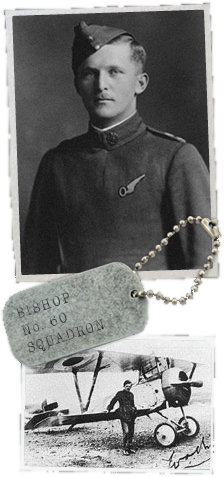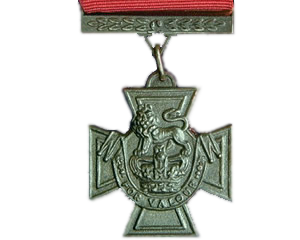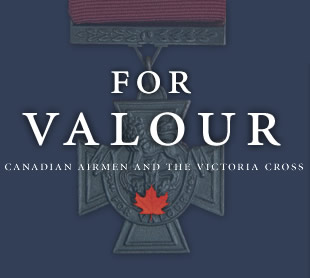William Bishop
Military Life
Avoiding Death
Billy Bishop avoided certain death many times, often by happenstance. In the fall of 1914 Billy left the College and was commissioned into the Mississauga Horse of Toronto regiment, a cavalry detachment of the 2nd Canadian Division. There he would catch pneumonia and be kept behind while his unit went to England, where the Division would suffer serious casualties while at the front. Still in Canada, he was assigned to the 7th Canadian Mounted Rifles and would move overseas with the unit in June 1915. During the journey across the Atlantic to England, two of the ships in Bishop’s convoy were sunk, with a number of lives lost.
After only one month in the trenches (and tired and frustrated with the mud and rain), Bishop applied to the Royal Flying Corps as an observer – it was quicker to transfer to the RFC as an observer than as a pilot. On 1 Sept 1915 Bishop reported to 21 (Training) Squadron for elementary air instruction, and the squadron moved to France in January 1916, where they conducted long-range reconnaissance flights over the front. Toward the end of his first operational, Bishop was sent back to England in May to recover from a series of non battle-related injuries. During this time, Bishop escaped heavy casualties suffered by his squadron. Again, illness and chance spared him from what would have likely been his death.
In the Air
Following his recovery and leave in Canada, Bishop returned to England in September 1916 determined to become a pilot. Although rejected for training numerous times for medical reasons, Bishop’s hopes and dreams were finally realized when after being accepted for training, he was awarded with his Pilots Wings. Following the completion of his pilot’s training was assigned to No. 37 Home Defence Squadron at Sutton’s Farm. Bishop became bored with the level of inactivity, and soon requested a transfer to the Western Front. In March 1917 he was posted to No. 60 Squadron in France, and took the helm of a Nieuport 17 in combat in March.
Less than a month after piloting his first mission, Billy Bishop had earned both the Military Cross and Distinguished Service Order, having downed 17 aircraft by the end of April. But his good fortune wasn’t shared by No. 60 Squadron – they lost many men during this time including Albert Ball, a mentor figure to Bishop and an ace credited with 44 victories.
Citation for the Military Cross
For conspicuous gallantry and devotion to duty. He attacked a hostile balloon on the ground, dispersed the crew and destroyed the balloon, and also drove down a hostile machine which attacked him. He has on several other occasions brought down hostile machines.
Citation for the Distinguished Service Order
For conspicuous gallantry and devotion to duty. While in a single seater he attacked three hostile machines, two of which he brought down, although in the meantime he was himself attacked by four other hostile machines. His courage and determination have set a fine example to others.
Citation for Bar to the Distinguished Service Order
For conspicuous gallantry and devotion to duty when engaging hostile aircraft. His consistent dash and great fearlessness have set a magnificent example to the pilots of his squadron. He has destroyed no less than 45 hostile machines within the past five months, frequently attacking enemy formations single handed, and on all occasions displaying a fighting spirit and determination to get to close quarters with his opponents which have earned the admiration of all in contact with him.
Citation for the Distinguished Flying Cross
A most successful and fearless fighter in the air, whose acts of outstanding bravery have already been recognized by the awards of the Victoria Cross, Distinguished Service Order, Bar to the Distinguished Service Order and Military Cross. For the award of the Distinguished Flying Cross now bestowed upon him he has rendered signally valuable services in personally destroying twenty-five enemy machines in twelve days, five of which he destroyed on his last day of service at the front. The total number of machines destroyed by this distinguished officer is seventy-two, and his value as a moral factor to the Royal Air Force cannot be overestimated.
Bishop’s solo raid
Following a well-deserved break in England in May 1917, a rested and energized Bishop returned to the front later that month. It wasn’t long before he was thinking about undertaking a mission he and Ball had planned before Ball’s death – attacking a German airfield early in the morning. On 2 June, despite the fact that he couldn’t get anyone to fly the mission with him, Bishop took off and headed toward enemy territory.
After the raid
Billy Bishop returned to Canada later in 1917, marrying Margaret Burden in October of that year. He was then assigned to the British War Mission in Washington, D.C. before being shipped back overseas. In April 1918, Bishop took command of No. 85 Squadron as a Major, and took his chosen pilots with him to the front in France the next month. From late May to early June, Billy Bishop downed fourteen more aircraft, reclaiming the title of the leading Allied ace. He was promoted to Lieutenant-Colonel a few months before armistice.











